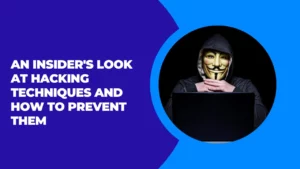Physical Address
304 North Cardinal St.
Dorchester Center, MA 02124
Physical Address
304 North Cardinal St.
Dorchester Center, MA 02124

In today’s world, where everything is digital and online, cyber threats are becoming more common. Cyber attacks can be disastrous for individuals and businesses alike. From financial loss to reputational damage, the effects of a cyber attack can be long-lasting. It is essential to understand what hacking techniques are and how to prevent them from happening.
In this blog post, we will take an insider’s look at various hacking techniques used by black hat hackers, white hat hackers, and gray hat hackers. We will also discuss the evolution of hacking and the common vulnerabilities that hackers exploit in their attacks. Lastly, we will provide best practices for preventing cyber attacks, including regular software updates and two-factor authentication.
Buckle up as we take you on a ride through the world of hacking and cybersecurity to ensure that you stay protected against cyber threats.
Learn about various hacking techniques employed by cybercriminals, ensuring you understand the importance of robust prevention measures. Stay updated on the latest security vulnerabilities and implement strong password and authentication protocols, as it is always a good idea. Protect your systems with firewall and antivirus solutions to safeguard against malware.
By being aware of the different types of attacks, such as DDoS and spyware, and staying educated on their prevention, you can minimize the risk of unauthorized access to your digital devices and the theft of financial information. Stay one step ahead of the bad guys by taking proactive measures to enhance your cybersecurity.

The early hacking methods and techniques paved the way for the evolution of hacking as technology advanced. With each advancement, hackers found new vulnerabilities to exploit and infiltrate systems. The impact of hacking on industries and individuals cannot be understated, as it has led to data breaches, the theft of credit card details, and unauthorized access to social media accounts.
Famous hacking incidents like the Kevin Mitnick case and the Sloan-Kettering Cancer Center breach have shaped the cybersecurity landscape. As technology continues to evolve, so do hacking techniques, making prevention strategies crucial to safeguarding against hack attacks.
Delving into the origins of hacking and the trailblazers of yesteryear who pioneered this unconventional art. Uncovering the techniques employed by these early hackers, allowed them to trespass into restricted spaces. Peering into the motivations that fueled their activities, from curiosity to criminal intent.
Examining the security vulnerabilities they seized upon during that era, exploiting weaknesses for personal gain. Assessing the invaluable lessons learned from the aftermath of these early hacking incidents. Understanding how their actions paved the way for a more vigilant and security-conscious digital landscape.
This concern became real when, in the same year, a gang of teenage hackers in Milwaukee, Wisconsin, known as The 414s, broke into computer systems throughout the United States and Canada, including those of Los Alamos National Laboratory, Sloan-Kettering Cancer Center, and Security Pacific Bank.
Explore the latest trends and techniques used by cybercriminals to compromise security. Social engineering plays a significant role in modern hacking attacks, manipulating individuals to divulge sensitive information. Advanced persistent threats (APTs) pose a severe threat, combining stealthy infiltration with long-term access to valuable data.
Hackers also exploit vulnerabilities in IoT devices, taking advantage of weak security measures. Android devices, in particular, have a more open-source and inconsistent software development process than Apple devices, which puts them at risk of data theft or corruption.
Additionally, the growing threat of ransomware attacks emphasizes the need for robust cybersecurity practices. Stay vigilant and informed to protect yourself and your organization from these ever-evolving hacking techniques.

In order to gain a comprehensive understanding of hacking, it is important to explore the different categories of hackers. Black hat hackers, driven by malicious intent, pose a significant threat to cybersecurity. On the other hand, white hat hackers, also known as the good guys, contribute to the protection of digital systems by identifying vulnerabilities before they are exploited.
Grey hat Hackers operate in a moral gray area, often exposing security flaws while also bending ethical boundaries. Delving into the dynamics of the hacker community provides valuable insights into the motives, goals, and ethical dilemmas faced by hackers.
Understanding the motives behind black hat hackers is crucial in combating their malicious activities. These hackers engage in cybercriminal activities for financial gain or corporate espionage purposes, as well as for more malicious purposes such as carrying out nation-state hacking campaigns or gaining a reputation.
They exploit vulnerabilities in systems and networks, risking personal gain or notoriety. Real-world examples of black hat hacking incidents serve as a stark reminder of the risks involved. It is important to recognize the legal and ethical ramifications associated with such activities.
By understanding the motives driving black hat hackers, we can better protect ourselves and our digital devices from their nefarious actions.
White hat hackers play a crucial role in maintaining cybersecurity by identifying and fixing system vulnerabilities. Ethical hacking and responsible disclosure are of paramount importance to ensure the security of digital devices and different accounts.
Renowned white hat hackers, such as Kevin Mitnick, have made significant contributions to the industry. Organizations can engage white hat hackers for proactive security testing to stay one step ahead of the bad guys.
By employing their expertise, white hat hackers help protect sensitive information, safeguard national security, and prevent potential cyber attacks.
Grey hat hackers find themselves in a unique ethical dilemma as they navigate the world of cybersecurity. Motivated by a desire to expose security flaws and raise public attention, they use controversial methods to achieve their goals.
However, these actions often come with legal consequences. Within the cybersecurity community, perspectives on grey hat hacking vary. While some view it as a necessary means to uncover vulnerabilities, others argue that it blurs the lines between good and bad.
Understanding the ethical dilemmas faced by grey hat hackers sheds light on the complex dynamics of the hacking landscape.

Hackers are always on the lookout for security vulnerabilities to exploit, targeting different types of weaknesses in network systems. They employ various common exploits to compromise computer systems and gain unauthorized access to sensitive information.
One area of concern is the impact of social engineering attacks, which manipulate individuals and organizations into divulging confidential data. To mitigate these vulnerabilities, it is crucial to stay informed about the latest security patches and updates.
By being proactive and implementing necessary measures, such as using strong passwords and regularly updating software, individuals and organizations can protect themselves from potential cyber threats. Hackers may gain backdoor access by infecting a computer or system with a Trojan horse, created by hackers to acquire and steal important data without the victim noticing.
Discover the art of manipulating individuals through social engineering techniques. Gain knowledge of the psychological tactics employed by hackers in these attacks.
Be equipped with effective strategies to mitigate social engineering attempts. Educate your employees on recognizing and responding to these deceptive tactics. Stay vigilant by staying updated on the latest trends and attack vectors in social engineering.
To protect your online accounts from unauthorized access, it is crucial to use strong passwords and secure credentials that incorporate a combination of letters, numbers, and special characters. Regularly updating your passwords adds an extra layer of security and reduces the risk of password attacks.
Implementing password encryption ensures that your sensitive information remains protected even if your credentials are compromised. Educating users about password security emphasizes the importance of creating unique and robust passwords. To simplify password management, consider utilizing password managers which securely store and manage all your passwords.
Phishing attacks continue to be a major threat to internet users worldwide. It is crucial to exercise caution when dealing with suspicious emails that request personal information. Always verify the authenticity of email senders before clicking on any links or providing sensitive data. Installing anti-phishing software can help detect and block phishing attempts.
Additionally, training employees to recognize and report phishing emails is essential in mitigating the risk. Regularly updating and patching email client software is also important to address vulnerabilities. Stay vigilant and proactive in protecting yourself and your organization from phishing attacks.

Regularly updating software to patch security vulnerabilities is crucial in preventing cyber attacks. Alongside this, implementing a comprehensive cybersecurity training program for employees can significantly enhance the organization’s security posture. Utilizing firewalls and intrusion detection systems to monitor network traffic helps identify potential threats.
Regular security audits play a vital role in identifying and addressing any weaknesses in the system. Implementing strict access controls is essential to limit unauthorized access to sensitive data. By following these best practices, organizations can effectively protect themselves against cyber threats.
To ensure the security of your systems, regularly check for and install software updates. Enable automatic updates to ensure patches are installed in a timely manner. It’s important to update all software applications, including operating systems and third-party programs, to protect against malware, viruses, and trojans.
Stay vigilant by checking software vendor websites for security advisories and patches. Consider using vulnerability scanning tools to identify any outdated software that may pose a risk. By prioritizing regular software updates, you can protect your systems from potential vulnerabilities.
To ensure robust password security, it is crucial to implement password policies that require a minimum length and complexity. Additionally, enforcing password expiration and preventing the reuse of previous passwords can significantly enhance protection against unauthorized access.
Implementing multi-factor authentication adds an extra layer of security, making it harder for hackers to gain access to sensitive information. Providing training on password best practices and emphasizing the importance of strong passwords helps employees understand the significance of their role in maintaining a secure environment.
Lastly, implementing password management tools allows for the secure storage and generation of passwords.
To enhance the security of your accounts, implementing two-factor authentication, such as using a unique gesture or a secure PIN, is crucial. By adding an extra layer of protection, you can safeguard your sensitive information from unauthorized access. Biometric authentication methods, such as fingerprint or face recognition, provide a highly secure means of verification.
Using one-time passwords or authentication apps can also strengthen your account security by ensuring that only you have access to the unique codes. It is important to enable two-factor authentication for all critical accounts and regularly review and update the settings for optimum security.
Additionally, it is recommended to install Find My iPhone (Apple) or set up Find My Device (Android) in case your phone goes missing.
To ensure the security of organizations against cyber threats, it is crucial to conduct regular cybersecurity risk assessments, identifying vulnerabilities and weaknesses within the system. Developing and enforcing a comprehensive cybersecurity policy can help establish guidelines and protocols for employees to follow, reducing potential risks.
In addition, creating incident response plans that outline how to effectively respond to cyber threats is essential. Implementing robust backup and disaster recovery measures enables organizations to recover quickly in case of an attack. Lastly, educating employees on cybersecurity best practices can help prevent future breaches.
In conclusion, staying up to date with the latest hacking techniques and understanding their prevention measures is crucial in today’s digital age. From early hacking methods to modern trends, it’s important to be aware of the different types of hackers and their motives.
Additionally, understanding common vulnerabilities that hackers exploit, such as social engineering attacks and phishing, can help you take necessary precautions. Implementing best practices like regular software updates, complex password policies, and two-factor authentication can significantly enhance your cybersecurity.
Organizations must prioritize staying protected against cyber threats by investing in robust security measures and educating their employees about potential risks. By taking proactive steps, we can create a safer digital environment for both individuals and businesses.